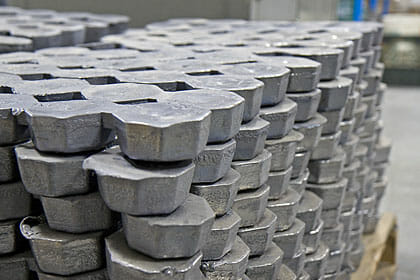
Molten lead and lead wool are often called lead caulk.
Lead caulk can be used for waterproofing joints. Lead is very stable and a lead moisture barrier will last as long as most buildings. (Lead Roofs have been known to last 200 years) Lead can be used to joint cast iron pipes, line reflecting pools, fountains, plant boxes, and more. Sheet lead with lead caulked joints can be used to create a perfect water barrier.
For the jointing of cast iron lead pipes it is sometimes permissible to use lead wool (sometimes called shredded lead), which can be caulked cold, but molten lead is often required.
Lead Wool consists of chemical grade lead drawn in long, fine strands. These strands are then twisted together into 5/8 inch rope.
Cast-Iron Soil Pipes
Lead caulking is used in commercial construction building applications, most commonly in the joining or sealing of cast iron soil pipes. The lead used for this purpose must be liquefied. Working with molten lead can lead to exposure to lead-oxide fumes and should be not be attempted without proper training and safety equipment, lead pots should include a portable local exhaust ventilation system mounted directly on or near the pot to control lead fumes.
When sealing a joint with lead care must be taken to ensure that the gap between hub and spigot end are of equal width all around the hub. After Oakum is packed into the joint lead is poured evenly around the joint and caulked with a caulking iron, taking care not to pack the lead too tightly, to insure the hub will not crack.
For a complete listing of products available on this site, go to the products and services index page .